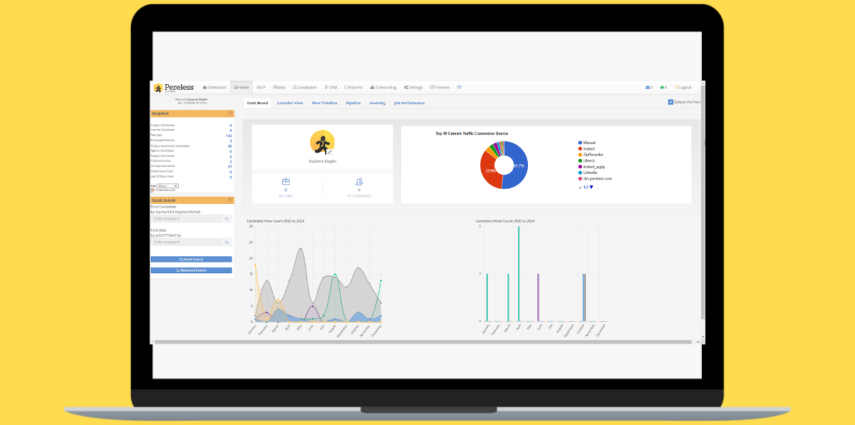In today’s competitive talent landscape, hiring decisions can no longer rely on gut feelings and outdated methods. Companies that want to attract and retain top talent need to make smarter, faster, and more informed hiring decisions. That’s where data-driven hiring comes in.
By leveraging analytics, organizations can transform their hiring process into a strategic advantage — improving quality of hire, reducing time-to-fill, and ultimately aligning recruitment with business goals.
What is Data-Driven Hiring?
Data-driven recruitment is the process of using data, metrics, and analytics to guide hiring decisions. It involves collecting and analyzing data from various stages of the recruitment funnel from sourcing and screening to interviews and onboarding to identify trends, improve efficiency, and make evidence-based decisions.
Rather than relying on intuition or assumptions, data-driven recruitment empowers talent acquisition teams with actionable insights.
Why Data-Driven Hiring Matters
1. Improved Quality of Hire:
By analyzing historical data on high-performing employees, recruiters can identify the traits, experiences, and skills that correlate with success — and target candidates who match that profile.
2. Reduced Time-to-Hire:
Data helps pinpoint bottlenecks in the hiring process. Are candidates dropping off at the interview stage? Is the sourcing strategy ineffective? Identifying these issues can speed up hiring timelines without sacrificing quality.
3. Enhanced Candidate Experience:
Metrics such as application drop-off rates or candidate satisfaction scores (via surveys) can highlight where the experience is falling short, allowing recruiters to optimize communication and engagement.
4. Bias Reduction:
Analytics can help spot and reduce unconscious bias by standardizing evaluations and identifying patterns of discrimination in hiring decisions.
5. Cost Optimization:
Hiring costs add up quickly. By tracking cost-per-hire, source effectiveness, and recruiter efficiency, companies can optimize budget allocation and reduce unnecessary spending.
Key Metrics in Data-Driven Hiring
To make the most of analytics, here are some core metrics you should be tracking:
- Time to Fill: How long it takes to fill a role from job posting to offer acceptance.
- Cost per Hire: Total recruiting costs divided by the number of hires.
- Source of Hire: Which platforms or channels are yielding the best candidates.
- Quality of Hire: Performance and retention of new hires, often measured after 6–12 months.
- Applicant Drop-off Rate: How many applicants abandon the application process.
- Interview-to-Offer Ratio: Number of interviews needed to make an offer.
- Diversity Metrics: Demographics of candidates at each recruitment stage.
How to Implement Data-Driven Hiring
1. Set Clear Goals
Start with clear recruitment objectives. Are you trying to reduce turnover? Increase diversity? Improve hiring speed? Your goals will determine which data to collect and analyze.
2. Leverage the Right Tools
Invest in technology that enables data collection and analysis. Common tools include:
- Applicant Tracking Systems (ATS)
- Recruitment Marketing Platforms
- HR Analytics Software
- AI Screening Tools
3. Integrate Your Data Sources
Siloed data limits insight. Ensure your recruitment data can be integrated across platforms — from sourcing tools to onboarding systems.
4. Train Your Team
Recruiters and hiring managers need to understand how to interpret and act on recruitment data. Provide training on using analytics tools and reading key metrics.
5. Test and Iterate
Use A/B testing for job descriptions, interview formats, or sourcing channels to see what works best. Continuously refine your approach based on what the data reveals.
Real-World Example
A fast-growing tech company struggling with high turnover among new hires used data analytics to evaluate their hiring process. They found that candidates hired through employee referrals had higher performance scores and longer tenure than those sourced through job boards. By reallocating budget and focus to referral programs and using structured interviews to assess fit more accurately, they reduced first-year attrition by 25%.
Bradford’s Key Takeaway:

In a world where talent is one of the biggest differentiators for business success, relying on instinct is no longer enough. Data-driven hiring provides the clarity, efficiency, and strategic advantage modern organizations need to attract and retain the right people.
Whether you’re a startup hiring your first few employees or an enterprise scaling globally, the message is clear: hiring smarter starts with your data.









